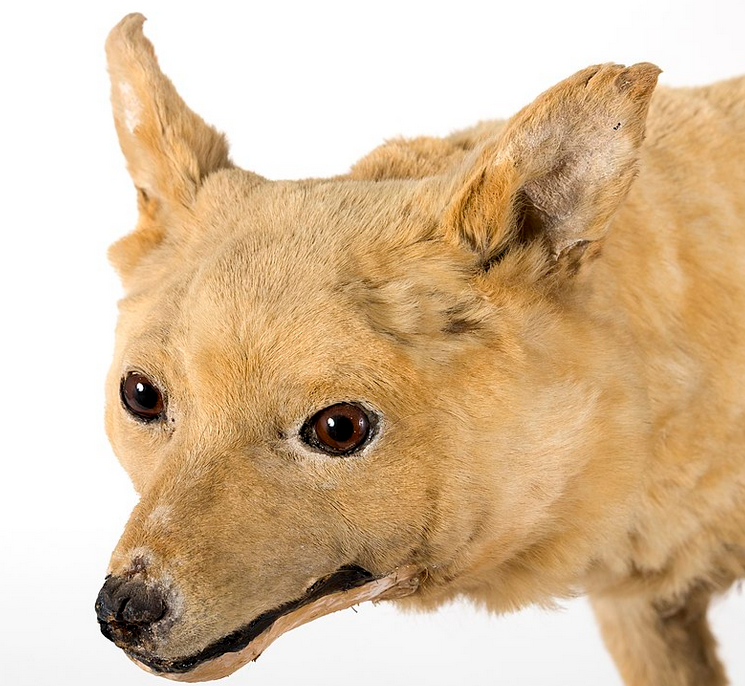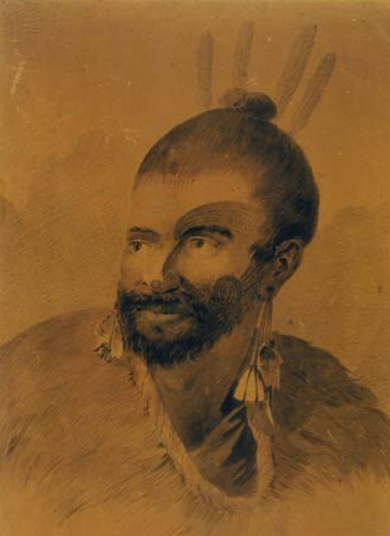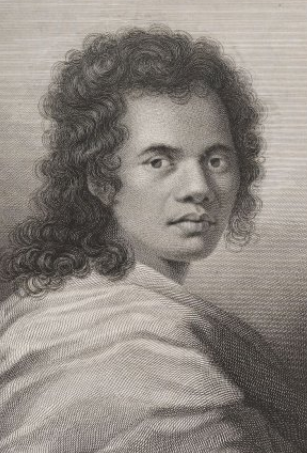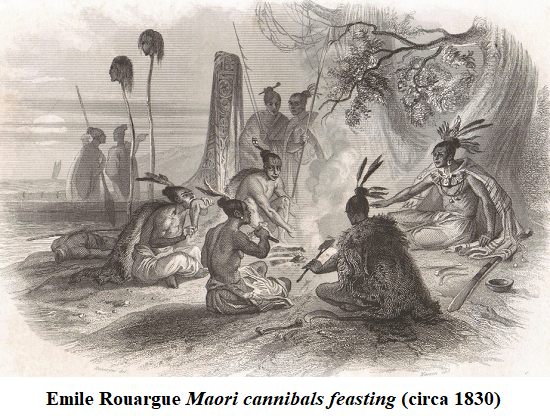
British sailors on naval vessels during the late eighteenth century did not openly criticise their captain—it would have incurred a flogging. As for staging a demonstration against the captain, even a small jokey protest, this was the worst possible thing a seafarer might do aboard ship. Such conduct was mutinous, and led to the scaffold.
This essay appears in the latest Quadrant.
Click here to subscribe
Yet the view has latterly gained currency in the history profession that on February 24, 1777, while in New Zealand, a group of his midshipmen held a form of protest against Captain Cook. This was on his third Pacific voyage, and at issue were the murders, then consumption in a cannibal rite, of ten sailors by Maori warriors on the previous expedition. That ghastly event had occurred in a large cove close to Cook’s preferred anchorage on Queen Charlotte Sound. (I wrote on this incident and its aftermath in Quadrant, June 2021.)
Cook was determined to maintain peace with the Maoris when his third expedition returned to Queen Charlotte Sound. So he told the officers and crew he would not be hunting out and  punishing those responsible. Executions would not tarnish this visit. The sailors were also warned not to take matters into their own hands. Vengeance in any form would not be tolerated. Nonetheless, tension was in the air when the warrior chief Kahura (right), who had led the killings, eventually approached the ships and made it known he wished to meet Cook. In an incident historians now call “The Trial of the Cannibal Dog”, several midshipmen vented their anger and frustration by staging a small symbolic protest. Under the watchful eye of Lieutenant James Burney, the young officer who had discovered the butchered corpses four years earlier, this took place on the consort ship Discovery even as Cook met with and forgave Kahura aboard his main vessel, Resolution. There were no repercussions afterward. Burney and the midshipmen inexplicably evaded a court-martial for what was a major breach of naval discipline.
punishing those responsible. Executions would not tarnish this visit. The sailors were also warned not to take matters into their own hands. Vengeance in any form would not be tolerated. Nonetheless, tension was in the air when the warrior chief Kahura (right), who had led the killings, eventually approached the ships and made it known he wished to meet Cook. In an incident historians now call “The Trial of the Cannibal Dog”, several midshipmen vented their anger and frustration by staging a small symbolic protest. Under the watchful eye of Lieutenant James Burney, the young officer who had discovered the butchered corpses four years earlier, this took place on the consort ship Discovery even as Cook met with and forgave Kahura aboard his main vessel, Resolution. There were no repercussions afterward. Burney and the midshipmen inexplicably evaded a court-martial for what was a major breach of naval discipline.
In his 2011 book Captain Cook: Master of the Seas, the professional biographer Frank McLynn summarises what the disgruntled midshipmen got up to on the day:
While Kahura went on deck to have his portrait painted by Webber, Omai bearded Cook in the Great Cabin and raged at him: “Why do you not kill him? You tell me if a white man kills another in England he is hanged for it and yet you will not kill him, even though a great many of his own people would like that and it would be very good.”
The general derision felt for Cook by his crew found expression on the Discovery, where James Burney connived at and encouraged an express act of defiance and contempt for his commander. Edward Riou had acquired a pariah dog from the Maoris, which was deeply unpopular as it liked to bite people. The midshipmen and master’s mates staged a mock trial of this dog for cannibalism, convicted it, killed it, then cooked and ate it.[1]
McLynn relies here entirely on the research work of Anne Salmond, a Distinguished Professor and Pro-Vice-Chancellor at Auckland University. He may cite a mixture of sources, but McLynn is uncritically repeating what appeared in her pioneering books—which combined anthropology with narrative history—Between Worlds: Early Exchanges between Maori and Europeans (1997) and The Trial of the Cannibal Dog: Captain Cook in the South Seas (2003). Having initially described the dog episode in the earlier book, Salmond chose to expand and feature it prominently with the latter work, which was awarded New Zealand’s prized Montana Medal for Non-Fiction upon publication. An in-depth investigation into Cook’s interactions with Pacific peoples, this study is now essential reading on the British exploration of Polynesia.
 Besides using The Trial of the Cannibal Dog as her book’s attention-catching title, Salmond uses its entire first chapter to examine the unusual incident, and even offers a set of historical precedents. In her account of Cook’s meeting with Kahura, the Tahitian translator Omai (left) erupted when Cook instructed the expedition’s artist, John Webber, to make a portrait of Kahura, killer of the Adventure’s men. The sailors were likewise angered at the gesture, feeling their captain was going too far. They were also disappointed that the expedition’s second-in-command, Commander Charles Clerke, stood by and made no comment. Insult had been added to injury. “Although Clerke agreed that there was no purpose to be served by killing Kahura,” Salmond explains:
Besides using The Trial of the Cannibal Dog as her book’s attention-catching title, Salmond uses its entire first chapter to examine the unusual incident, and even offers a set of historical precedents. In her account of Cook’s meeting with Kahura, the Tahitian translator Omai (left) erupted when Cook instructed the expedition’s artist, John Webber, to make a portrait of Kahura, killer of the Adventure’s men. The sailors were likewise angered at the gesture, feeling their captain was going too far. They were also disappointed that the expedition’s second-in-command, Commander Charles Clerke, stood by and made no comment. Insult had been added to injury. “Although Clerke agreed that there was no purpose to be served by killing Kahura,” Salmond explains:
Many of the sailors were of a mind with [Omai] and found their impotence galling. Burney spoke for them when he wrote: “it seemed evident that many of them held us in great contempt and I believe chiefly on account of not avenging the affair of Grass Cove, so contrary to the principals by which they would have been actuated in the like case”.
The scene was now set for the mock trial of the dog on board the Discovery. James Burney, the living witness of what had happened at Grass Cove and the ship’s first lieutenant, was chafing at Cook’s failure to act. The Discovery was Cook’s consort ship, so the trial was staged at a safe distance from their commander. It was a marvellous way of letting Cook and Clerke know what the sailors (and some of their officers) thought of Maori cannibals, and how they ought to be handled.[2]
Salmond remarks that this whole incident brings to mind “The Great Cat Massacre”—the subject of a 1983 essay by the American historian Robert Darnton.[3] In it he argued that a purported incident in 1730s Paris, where two apprentices played a practical joke on their employer which ended in the killing of numerous cats, constituted a rebellion against harsh workplace relations imposed under France’s ancien régime. Having explained Darnton’s piece, Salmond repeats at length the historical precedents he cited, using them to boost her own case. And she takes the metaphor further. Besides venting their anger at Cook, by eating a native dog they had purchased from Maoris in trade, the midshipmen were symbolically enacting revenge against the Maori cannibals who previously ate the English sailors.[4]

There are difficulties here. Seemingly small, but significant ones. They begin with the sequence of events.
Salmond has Kahura come aboard ship and meet Cook; the captain then takes Kahura into the Great Cabin where he instructs Webber to make Kahura’s portrait; next an indignant Omai abuses Kahura, calling for his death. It is after this that Salmond has the midshipmen get up to mischief. But events do not follow this sequence in the journals of James Cook and others present.[5] They have Kahura arrive at the ship where an indignant Omai immediately abused him, calling for his death; Kahura next came aboard and met with Cook in the Great Cabin, with Clerke and others in attendance. It was only then, after a long conversation in which Cook assured the Maori he would not take revenge, and a sorrowful Kahura confessed to the killings and cannibalism, that the captain instructed Webber to make Kahura’s portrait. The change in sequence may be small, but it indicates lack of attention.
Other seamen’s journals indicate further flaws. When Salmond’s text is checked against the entry in James Burney’s journal, nothing seems to square. Here is the passage he wrote that evening from which the comment (in italics) was lifted by Salmond:
The New Zealanders of Queen Charlotte Sound were never so much among us as this time. The reason probably because they found more was got and on easier terms than ever before, for our folk were all so eager after curiosities and withall so much better provided than any other Voyage, that Traffick was greatly altered in favour of the Indians, a nail on the last Voyage purchasing more than an Axe or Hatchet now. Before our departure Hatchets were slung under their Cloathes instead of Patows—They often appeared to have great Friendship for us, speaking sometimes in the most compassionate tone of Voice imaginable—but it not a little disgusted one to find all this Show of fondness interested and it constantly ended in begging. If gratified with their first demand they would immediately fancy something else, their expectations and importunities increasing in proportion as they had been indulged—We had instances of their quarrelling after having begged 3 things, because a fourth was denied them—it seemed evident that many of them held us in great contempt and I believe chiefly on account of our not avenging the Affair of Grass Cove, so contrary to the principle by which they would have been actuated in the like Case.[6]
The historian has quoted Lieutenant Burney out of context. His remark appears in an account of the relaxed manner in which trade with natives had occurred. He may not have been pleased that the killers had got off, and he complained elsewhere in his journal, “one man did not scruple to acknowledge his being present and assisting at the killing and eating the [sailors]”, but there is not a scrap of evidence to suggest Burney was, as Salmond claims, “chafing” to take action.[7]
It must also be noted that Lieutenant Burney makes no reference in this, or in other entries, to  midshipmen on his ship holding a mock trial of a dog, then eating it. Nor does he write of supporting defiant talk by sailors, of his frustration with either Cook or Clerke, or refer to Cook and Kahura meeting on the Resolution. He does not even mention John Webber drawing and painting the portrait of Kahura which Salmond insists greatly annoyed him. Both vessels were departing with the tide next morning, so we find Burney setting down final thoughts on a people he would not encounter again. No words are spent on Kahura, who, during the entire stopover, appears only briefly in Burney’s notes.
midshipmen on his ship holding a mock trial of a dog, then eating it. Nor does he write of supporting defiant talk by sailors, of his frustration with either Cook or Clerke, or refer to Cook and Kahura meeting on the Resolution. He does not even mention John Webber drawing and painting the portrait of Kahura which Salmond insists greatly annoyed him. Both vessels were departing with the tide next morning, so we find Burney setting down final thoughts on a people he would not encounter again. No words are spent on Kahura, who, during the entire stopover, appears only briefly in Burney’s notes.
No mention of the dog incident is found among documents from the Pacific expedition. Instead, it is among a store of anecdotes reputedly much recited by Alexander Home. He had served as an adult midshipman on the Discovery, for a time acting as master’s mate. Some years later, after being left disabled by an accident aboard another navy ship, he retired on half-pay with the courtesy rank of commander. Blind and near immobile, Home then spent his final years in the family home, craving an audience for his sea stories. “He was full of narrative,” his son George remarked; but “taking advantage of his blindness, we, his hopeful offspring, slipped quietly off, one by one, leaving, the old Commodore in his arm-chair.”[8] When served a generous meal, the aged mariner would habitually reminisce on one prank aboard the Discovery:
When we were in New Zealand, Neddy Rhio, one of my messmates had got hold of a New Zealand dog, as savage a devil as the savages from whom he got it, and this same dog he intended to bring home to present to the Marchioness of Townsend, his patroness.[9] But one day, when Neddy was on shore on duty, a court-martial was held on the dog, and it was agreed nem.con. that, as the dog was of cannibal origin, and was completely a cannibal itself, having bit every one of us, and shewn every inclination to eat us alive if he could, that he should be doomed to death, and eat in his turn, we being short of fresh provisions at the time.
The sentence was immediately executed, the dog cooked, dressed, and eat, for we could have eat a horse behind the saddle, we were all so confoundedly hungry; but, considering that Neddy had the best right to a share, we put past his portion in a wooden bowl, and by way of having some sport, we cut a hole in the dog’s skin, and as Neddy came up the side, I popped his own dog’s skin over his head with the tail hanging down behind, and the paws before. He looked the grin horrid, told us we were all a set of d—d cannibals, as bad as the New Zealanders we were amongst, and dived down below quite in the sulks.[10]
Salmond quotes this passage in full, although in neither of her books does she explain the source. Home’s anecdote appears in the memoirs of his son, Lieutenant George Home, which were published in 1838—fifteen years after his father died. And far from being a statement made by Alexander Home and directly taken down, the passage is his son’s effort to recite a yarn the long-deceased sailor often used to tell. So not only must the dog story be reclassified as posthumously passed through a secondary source, but scholarly custom insists that as an anecdote it be treated as corrupted, because anecdotes evolve over time through retelling.
Home said the dog had been purchased by Midshipman Rhio in New Zealand. The two ships stopped there once, remaining at Queen Charlotte Sound for the fortnight from February 11 to 24, 1777. However, Home did not identify when and where during the voyage the dog-eating incident occurred. The sole apparent clue is that the ship was running short of provisions. This eliminates Queen Charlotte Sound, because, as Cook noted, Maoris offering fresh food in trade were a constant presence.[11] Stops made later in Canada, Alaska or Siberia seem more likely. It may even be the incident took place months after the death of Cook, in the long troubled journey from the Bering Sea to the Indian Ocean. As well, in his anecdote Home makes no mention of Kahura, of the meeting with Cook, of the Adventure’s crewmen, or of Lieutenant Burney. There are just no grounds to introduce them.
Returning to Salmond’s account, she has the incident occurring in New Zealand on the same day as Cook met with Kahura. This was on the last day of the stopover there, and the ship sailed the next morning. So the midshipmen’s rebellious “trial” could only have taken place in the afternoon or evening of February 24. That day’s entry in the journal of David Samwell, the surgeon’s mate, records the arrival of Kahura that afternoon:
While we lay at anchor here two or three large Canoes came to us in the Afternoon full of Men, they brought several Dogs to sell & we purchased a few of them for a Hatchet each, they had brought many Articles of Trade such as Ahoos [patu], green Images called Tigis [tiki], Stone Adzes & c., being desirous of getting a few more of our Hatchets before we left them. In one of these Canoes was Kowura [Kahura] before mentioned; when Omai saw him he immediately went to Capt. Cook and begged that he wou’d give him permission to shoot him, saying that he was a very bad Man & that we ought to take revenge upon him for the Death of the Adventure’s People. It is hardly necessary to mention that his Request was denyed. The next Day Feby 25th we weighed and sailed out of Charlotte Sound …[12]
So on the day in question, Kahura and his kinsmen went to the ships to conduct trade, where, among other exchanges, they sold native dogs to the Europeans for a hatchet each. Might this even be when Midshipman Rhio purchased the creature? Kahura next went aboard the Resolution and had his meeting with Cook in the great cabin, then sat for John Webber to make a portrait. According to Salmond’s timeline, it was around this time that the other midshipmen staged the “trial”, then killed and ate the expensive recently-acquired dog as a rebel gesture against the captain. And they did this fully aware of the workload awaiting them first thing the next day when the ships departed New Zealand.
In the accounts of Anne Salmond and her followers the various elements that compose the “Trial of the Cannibal Dog” slot together like pieces of a jigsaw puzzle. But on close inspection the shapes will not fit. Instead, it appears the historical sources have been selectively edited and a false narrative made from disconnected details. The result makes an amusing tale, much used to publicise Salmond’s book, although it just could not have happened at the time and in the manner she described. Perhaps a mock “trial” of the Maori dog described by Alexander Home did occur on the quarter deck, yet it would have happened later in the voyage. And far from being a bold political act motivated by how Cook dealt with Kahura, it was probably an instance of innocent fun among fatigued and underfed sailors, far from Blighty, and trying to cope in a harsh physical environment.
Christopher Heathcote’s new book, The Compassion of Captain Cook, published by Connor Court, can be ordered here.
[1] Frank McLynn, Captain Cook: Master of the Seas, Yale University Press, New Haven, 2011, 293. Actually, Webber made the portrait of Kahura in his makeshift studio space in the Great Cabin, not on deck in open air.
[2] Anne Salmond, Trial of the Cannibal Dog: Captain Cook in the South Seas, Allen Lane, London, 2003, p.4.
[3] Robert Darnton, The Great Cat Massacre and Other Episodes in French Cultural History, Allen Lane, London, 1983.
[4] cf. Salmond, Trial of the Cannibal Dog, op.cit., pp.229-30.
[5] J.C. Beaglehole (editor), The Journals of Captain James Cook on His Voyages of Discovery, Vol.3: The Voyage of the Resolution and Discovery 1776-1780, Cambridge, at the University Press, for the Hakluyt Society, 1967, pt. 1,, pp.64-5; & pt.2, p.1001.
[6] James Burney, Journey on HMS Discovery 10 Feb. 1776 – 24 Aug. 1779, Safe 1/64; Safe 1/79, Mitchell Library, State Library of NSW,
vol.4., pp.25-6.
[7] Burney, Journey on HMS Discovery, op.cit., vol.1, pp.26-7.
[8] George Home, Memoirs of an Aristocrat, and Reminiscences of the Emperor Napoleon, by a midshipman of the Bellerophon, London, Whittaker & co., 1838, p.5.
[9] Home, Memoirs of an Aristocrat, op. cit., p.271.
[10] Home, Memoirs of an Aristocrat, op. cit., pp.271-2.
[11] Beaglehole, Journals of Cook, op.cit., vol. 3, pt. 1, p.61.
[12] Beaglehole, Journals of Cook, op.cit., vol. 3, pt.2, p.1001.
 Sign In
Sign In 0 Items (
0 Items ( Search
Search









Yes, however there was nothing fictional in it for the dog.